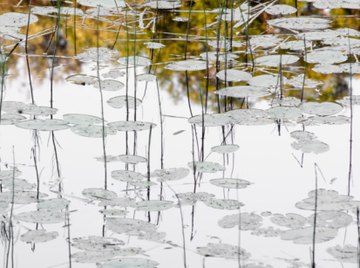
Life inside an aquarium, stream, pond and even in seas and oceans depends on aquatic plants. Aquatic plants provide food and oxygen to the water and the submerged habitat. Aquatic plants grow in three distinct patterns that describe how the plants do or do not affix to the soil at the bottom of the water body. Floating plants, unlike emerged and submerged plants, do not have fixed roots and therefore require little effort to safely remove and place into another body of water. Submerged and emerged plants, however, include shallow or deep root systems growing in the soil at the bottom of a pond, creek, river or the ocean floor.
Submerged Plants
Plants that grow entirely underwater, with root systems affixed to the soil at the bottom of the water body, are classified as submerged plants. The leaves, stems and any existing blooms of these plants lie totally submerged under normal water levels. These types of plants tend to have very soft textures that allow small waving and flowing when underwater. Many submerged plants include only leaves and stems and use root systems to spread. Examples of submerged plants include various species of seaweeds, eelgrass and pondweeds.
Emerged Plants
Emerged plants grow from roots affixed in the soil at the bottom of the water body to produce thick, strong stems that emerge several inches to several feet above the water’s surface. Emerged plants often have a few leaves that emerge from the submerged parts of stems, though most leaves and all blooms and seed pods generally grow on the emerged sections of the plant. Emerged plants include such plant species as lotuses, cattails and hornworts, which include various subspecies. Each species of emerged plant has specific depth requirements for growth, with some plants growing better just in the edge of the water, while others prefer depths between 1 and 2 feet.
Floating-Leaf Plants
While floating aquatic plants grow entirely on the surface of the water, with leaves, blooms and even root systems floating in the water, one type of fixed plant closely resembles this growth pattern. Another type of emergent plant, floating-leaf plants produce growth on the surface of the water and send long tendril-like root systems down to the soil bed at the bottom of the water body to affix the plant into place in the pond. Floating-leaf, affixed aquatic plants include such species as water lilies and water chestnuts, which have leaves and blooms that float above the surface of the water.
References
About the Author
Penny Porter is a full-time professional writer and a contributor to "Kraze" magazine. She is pursuing a bachelor's degree in journalism at Eastern Kentucky University in Richmond, Kentucky.
Photo Credits
Roine Magnusson/Photodisc/Getty Images
